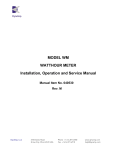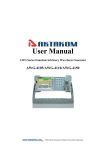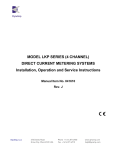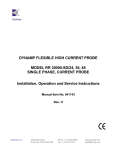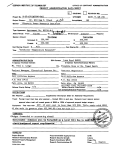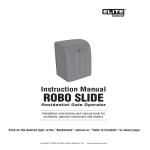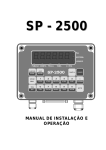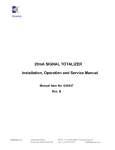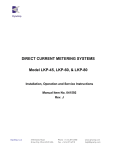Download LKAT Plus BI-DIRECTIONAL HIGH CURRENT
Transcript
LKAT Plus BI-DIRECTIONAL HIGH CURRENT MEASUREMENT SYSTEM Installation, Operation and Service Manual Manual Item No. 043636 Rev. Q DynAmp, LLC 3735 Gantz Road Grove City, Ohio 43123 USA Phone +1 614.871.6900 Fax +1 614.871.6910 www.dynamp.com [email protected] Installation, Operation and Service Manual LKAT Plus This Page is Intentionally Blank © 2012 DynAmp, LLC 043636 Q Page ii Installation, Operation and Service Manual LKAT Plus DynAmp, LLC WARRANTY Items and components manufactured by Seller for permanent installation are warranted for two (2) years from the date of shipment. Items and components manufactured by Seller for portable and temporary use in more than one location are warranted to be free from defects in material and workmanship for a period of eighteen (18) months from the date of shipment. Items and components not manufactured and resold by Seller are warranted by their manufacturer. Warranty repair shall be, at DynAmp’s option, in the form of repair or replacement of the defective items or components. Concerning warranty repairs, DynAmp, LLC will be responsible for DynAmp provided time, material and transportation costs (shipping or travel). Actual method of warranty repair / correction will be determined by DynAmp, LLC at DynAmp’s sole option. Such warranty repair shall constitute a fulfillment of all DynAmp, LLC liabilities in respect to said items and components. In no event shall DynAmp, LLC be liable for consequential damages. Information in this document is subject to change without notice. © 2001, 2002, 2003, 2004, 2005, 2006, 2009, 2010, 2011, 2012 DynAmp, LLC. All rights reserved. Reproduction for purposes other than operation and service without written permission of DynAmp, LLC is strictly forbidden. This manual includes detailed drawings, installation, operation, service and maintenance. Users should evaluate the information in the manual and their particular application. DynAmp, LLC assumes no liability for any incidental, indirect, or consequential damages arising from the use of this documentation. While all information presented is believed to be reliable and in accordance with accepted engineering practices, DynAmp,LLC makes no warranties as to the completeness of the information. © 2012 DynAmp, LLC 043636 Q Page iii Installation, Operation and Service Manual LKAT Plus This Page is Intentionally Blank © 2012 DynAmp, LLC 043636 Q Page iv Installation, Operation and Service Manual LKAT Plus The LKAT Plus Bi-Directional High Current Measurement System may be used with or without the optional Protection Extensions (“PE”) and / or RMS Display PC board assemblies. All configurations of the LKAT Plus System conform to the latest European directives and standards concerning safety and electromagnetic compatibility. Application of Council Directive(s): 73/23/EEC, 89/336/EEC and 93/68/EEC. Standards to which conformity is declared: Electrical Equipment for measurement, control, and laboratory use - EMC Requirements, EN61326:1997 edition, including Amendment 1:1998 and Amendment 2:2001 • • • • • • • • • EN55022:1998 edition - Information technology equipment – radio disturbance characteristics – Limits and methods of measurements EN61000-3-2:2000 edition - Electromagnetic Compatibility-Part 3:Testing and measurement techniques – Section 2: Harmonic current emissions EN61000-3-3:1995 edition - Electromagnetic Compatibility-Part 3:Testing and measurement techniques – Section 3: Voltage fluctuation and flicker test EN61000-4-2:1995 edition - Electromagnetic Compatibility-Part 4:Testing and measurement techniques – Section 2: Electrostatic discharge immunity test EN61000-4-3:1996 edition - Electromagnetic Compatibility-Part 4:Testing and measurement techniques – Section 3: Radiated, radio-frequency, electromagnetic field immunity test EN61000-4-4:1995 edition - Electromagnetic Compatibility-Part 4:Testing and measurement techniques – Section 4: Electrical fast transient/burst immunity test EN61000-4-5:1995 edition - Electromagnetic Compatibility-Part 4:Testing and measurement techniques – Section 5: Surge immunity test EN61000-4-6:1995 edition - Electromagnetic Compatibility-Part 4:Testing and measurement techniques – Section 6: Conducted immunity test EN61000-4-11:1995 edition - Electromagnetic Compatibility-Part 4:Testing and measurement techniques – Section 11: Voltage dips and interruptions immunity test immunity test Safety Standards: • EN61010-1:2001 edition - Safety of Electrical Equipment; Part I Note According to EN 61326, the manufacturer must state the degradation of performance level acceptable during immunity tests. Unless other wise noted in the manual or data sheet, DynAmp, LLC limits degradation during immunity tests for this equipment to < 1% FS for A-criterion tests. Under a small number of test conditions, the visual reading of optional RMS Display PC board assembly may deviate up to –35% FS. The display reading returns to specified performance when the RF disturbance is removed. This performance level is acceptable according EN 61326 B-criterion. © 2012 DynAmp, LLC 043636 Q Page v Installation, Operation and Service Manual LKAT Plus This Page is Intentionally Blank © 2012 DynAmp, LLC 043636 Q Page vi Installation, Operation and Service Manual LKAT Plus Hazard Warning! All installation, maintenance and service must be performed by qualified technicians who are familiar with the warnings and instructions of this manual. Disconnect power to the system before servicing or replacing fuses. Use of the equipment in a manner not specified by the manufacturer can impair the protection provided within. The enclosure cover must remain closed at all times during operation to ensure safety of personnel. The cover may be opened using a screwdriver; however, only authorized personnel or technicians should be allowed to open and service the unit. GENERAL DynAmp, LLC does not assume liability for the customer’s failure to comply with the rules and requirements provided in this manual. This equipment is designed to be connected to hazardous electric voltages. Ignoring the installation precautions and warnings can result in severe personal injury or equipment damage. HAZARDOUS VOLTAGE To avoid the risk of electrical shock or fire, the safety instructions and guidelines in this manual must be followed. The electrical specifications must not be exceeded and the unit must be installed according to directions provided. This equipment is intended for indoor or outdoor use. The ambient temperature must not exceed 80°C for the measuring head and 50°C for the electronics. For mounting considerations that fall outside the recommended specifications provided in this manual, the factory should be contacted for approval. INSTALLATION This unit is rated for installation category III and pollution degree 2. Symbol Identification: General definitions of safety symbols used on equipment and manual. Caution/Warning: Refer to accompanying documents for instructions. The CE mark proves the compliance of the equipment with the requirements of the directives. © 2012 DynAmp, LLC 043636 Q Page vii Installation, Operation and Service Manual LKAT Plus This Page is Intentionally Blank © 2012 DynAmp, LLC 043636 Q Page viii Installation, Operation and Service Manual LKAT Plus DynAmp, LLC Customer Support For further assistance, contact DynAmp Customer Support at: Americas: Telephone: +1 614.871.6900 Fax: +1 614.871.6910 8:00 AM to 5:00 PM USA Eastern Time From first Sunday in November to second Sunday in March – 13:00 GMT to 22:00 GMT From second Sunday in March to first Sunday in November – 12:00 GMT to 21:00 GMT Europe: Telephone: +41 22.706.1446 Fax: +41 22.706.1311 8:30 AM to 5:00 PM Central European Time From last Sunday in October to last Sunday in March – 7:30 GMT to 16:00 GMT From last Sunday in March to last Sunday in October – 6:30 GMT to 15:00 GMT After Hours Critical Service Emergency: Telephone: +1 614.871.6906 5:00 PM to 8:00 AM USA Eastern Time From first Sunday in November to second Sunday in March – 22:00 GMT to 13:00 GMT From second Sunday in March to first Sunday in November – 21:00 GMT to 12:00 GMT Central e-mail: [email protected] DynAmp web: www.dynamp.com © 2012 DynAmp, LLC 043636 Q Page ix Installation, Operation and Service Manual LKAT Plus This Page is Intentionally Blank © 2012 DynAmp, LLC 043636 Q Page x Installation, Operation and Service Manual LKAT Plus REVISION PAGE Page Change all 4, 5, 7, 8, 29 18, 19 Rev NEW A 3, 7, 9 C 28, 29 D 7 21,26 E F 12,15-21, 26, 30 G V, vii, 1, 5, 8 H all 11,12 Rev I Rev J 8 Rev K v, 1, 30 all Rev L Rev M 11 34 Rev N Rev O 9, 29, 35 Rev P ECR 1692, ECO 3268- Earth Ground Connections, Fix Table 4.1, MDCR0042 Added Technical Bulletin list 04/12 14,15 Rev Q ECR1765 – Remove “Bus Analysis” block, Figure 5.1 General Guidelines for Locating Measuring Heads 09/12 B © 2012 DynAmp, LLC 043636 Q Reason For Revision Date Minor changes, updated Tables 3-1, added section 5-9 “Field Configuration of Trip Setpoints” Changed power supply tolerance to ±0.5v. Changed acceptable differences to A1 vs. A2 and B1 vs. B2 Section 2-2 paragraph 3 deleted term “molded-on”, changed Section III Table 3-1 Temperature sensitivity for cable lengths/added Note 1. Added “Remove tape seal from switch SW1 and SW2, if necessary” Add “Minimum Load Resistance 25Ω” in Section III Changed contact status “open to closed and closed to open” in Tables 4-3 and 5-1 Updated Installation Section pages / Tables 4-1 & 4-2, removed Table 4-3, updated 5-6 “Troubleshooting AD fault and Spare Parts List 6-1 Updated with “CE” , Safety section –mains wire, Description 2-4 working voltage from 500V to 450V, Specifications -changed isolation to working voltage Update to DynAmp, LLC Update Installation Consideration 4-2, IP65 rating information Update Specifications Table 3-1, Ambient Temperature Range (Storage) Update fuse precautions per ECR 1304 Update per ECR 1511 / ECO 3216 –Specification, label, PAR 10245 – Handling & Storage, ECR 1440- Calibration Intervals / New Manual Format MDCR 0032 – Figure 4-1 ECR1639 – Correct Item number in table 7.1 09/01 03/02 06/02 02/03 06/03 08/03 09/03 10/03 04/04 11/04 04/05 06/05 07/06 10/09 08/10 05/11 Page xi Installation, Operation and Service Manual LKAT Plus This Page is Intentionally Blank © 2012 DynAmp, LLC 043636 Q Page xii Installation, Operation and Service Manual LKAT Plus TABLE OF CONTENTS Paragraph 1. Title Page SAFETY __________________________________________________________________ 1 1.1 OVERVIEW ......................................................................................................................... 1 2. HANDLING AND STORAGE ____________________________________________________ 3 3. DESCRIPTION ______________________________________________________________ 5 3.1 3.2 3.3 3.4 3.5 OVERVIEW ......................................................................................................................... 5 MEASURING HEAD ............................................................................................................ 5 METERING UNIT ................................................................................................................ 5 INDICATORS AND OUTPUTS ............................................................................................ 6 INTERCONNECTION CABLES........................................................................................... 7 4. SPECIFICATIONS ____________________________________________________________ 9 5. INSTALLATION _____________________________________________________________ 13 5.1 5.2 5.3 5.4 5.5 5.6 HANDLING PRECAUTIONS ............................................................................................. 13 INSTALLATION CONSIDERATIONS ................................................................................ 13 OFF-BUS FUNCTIONAL CHECK (Optional) ..................................................................... 14 HEAD INSTALLATION ...................................................................................................... 14 SYSTEM CHECKOUT....................................................................................................... 15 METERING UNIT INSTALLATION .................................................................................... 19 6. THEORY OF OPERATION ____________________________________________________ 21 6.1 6.2 6.3 6.4 6.5 6.6 6.7 6.8 6.9 6.10 GENERAL ......................................................................................................................... 21 OLOP TECHNOLOGY ...................................................................................................... 21 SYSTEM FUNCTIONAL DESCRIPTION........................................................................... 22 LKAT PLUS METERING UNIT .......................................................................................... 23 HEAD INTERCHANGEABILITY ........................................................................................ 23 TROUBLESHOOTING AN ACCURACY DIAGNOSTICS FAULT INDICATION................. 23 SYSTEM CALIBRATION OVERVIEW ............................................................................... 24 CALIBRATION PROCEDURE ........................................................................................... 25 FIELD CONFIGURATION OF TRIP SETPOINTS ............................................................. 27 EARTH GROUNDING ....................................................................................................... 29 7. MAINTENANCE & SPARE PARTS ______________________________________________ 31 7.1 7.2 7.3 7.4 PERIODIC MAINTENANCE .............................................................................................. 31 ANNUAL MAINTENANCE ................................................................................................. 31 RECOMMENDED SPARE PARTS .................................................................................... 32 SERVICE ASSISTANCE ................................................................................................... 33 8. TECHNICAL BULLETINS _____________________________________________________ 35 9. DRAWINGS ________________________________________________________________ 37 © 2012 DynAmp, LLC 043636 Q Page xiii Installation, Operation and Service Manual LKAT Plus FIGURES & TABLES FIGURE # TITLE FIGURE 4.1 FIGURE 6.1 FIGURE 6.2 FIGURE 6.3 FIGURE 6.4 ...................................................................................................... PAGE LKAT PLUS FREQUENCY RESPONSE .................................................................. 11 BLOCK DIAGRAM OF THE LKAT PLUS SYSTEM ..................................................... 22 LKAT PLUS SYSTEM TEST SETUP ...................................................................... 26 NAMEPLATE ...................................................................................................... 28 METERING UNIT EARTH GROUND CONNECTIONS .................................................. 30 TABLE 3.1 MAIN AND PE PC BOARD ASSEMBLY FEATURES ...................................................... 6 TABLE 4.1 LKAT PLUS SYSTEM SPECIFICATIONS ..................................................................... 9 TABLE 4.1 LKAT PLUS SYSTEM SPECIFICATIONS, CONTINUED ................................................ 10 TABLE 4.1 LKAT PLUS SYSTEM SPECIFICATIONS, CONTINUED ................................................ 11 TABLE 5.1 LKAT PLUS DIAGNOSTIC MEASUREMENTS FORM 1 – ZERO PRIMARY CURRENT ...... 17 TABLE 5.2 LKAT PLUS DIAGNOSTIC MEASUREMENTS FORM 2 – ENERGIZED PRIMARY BUS ...... 18 TABLE 6.1 TROUBLESHOOTING AN ACCURACY DIAGNOSTICS FAULT INDICATION ....................... 24 TABLE 6.2 TRIP CONFIGURATION DETAILS............................................................................. 28 TABLE 7.1 SPARE PARTS LIST.............................................................................................. 32 TABLE 8.1 TECHNICAL BULLETINS LIST ................................................................................. 35 TABLE 9.1 DRAWING LIST .................................................................................................... 37 © 2012 DynAmp, LLC 043636 Q Page xiv Installation, Operation and Service Manual LKAT Plus 1. SAFETY 1.1 OVERVIEW The measuring head is designed to be installed on high voltage bus bars. All interconnection cables must be safely routed away from bus bars and high voltages. Do not allow any interconnection cable to contact bus bars or high voltages. Ignoring the installation precautions and warnings can result in severe personal injury or equipment damage. The following are general guidelines to be followed during installation, operation and service of the metering unit and measuring head. • All installation, maintenance and service must be performed by qualified technicians who are familiar with the warnings and instructions of this manual. • Always follow all local and plant safety procedures. • The enclosure cover must remain closed at all times during operation to ensure safety of personnel. Only authorized personnel or technicians should be allowed to open and service the unit. • Replace fuse with correct type, size and value. Refer to the servicing instructions or spare parts list for more information on replacement fuses. Do not bypass the fuses or modify the electronics. Disconnect power to the system before replacing fuses. Failure to follow these instructions will result in intermittent operation and premature failure and will void the warranty. • Service must be performed by qualified technicians only. If use of an oscilloscope becomes necessary during servicing, either the scope must be floating and ungrounded, or differential probe(s) must be used. The metering unit is isolated from the mains via the power transformers. If a grounded scope is used, a hazardous condition is created since current will flow through the probe to ground. • Units are not intrinsically safe. Do not place in explosive atmospheres. • Use of the equipment in a manner not specified by the manufacturer can impair the protection provided within. The mains wiring should be sized 18AWG (1mm2) or larger and have an insulation rating of 1000Vac and 80-105° C temperature rating. • If a binding screw is used for the mains earth connection, the binding screw must be size M4 (No. 6) or larger. DynAmp, LLC does not assume liability for the customer’s failure to comply with the rules and requirements provided in this manual. • © 2012 DynAmp, LLC 043636 Q Page 1 Installation, Operation and Service Manual LKAT Plus This Page is Intentionally Blank © 2012 DynAmp, LLC 043636 Q Page 2 Installation, Operation and Service Manual LKAT Plus 2. HANDLING AND STORAGE DynAmp products are engineered and manufactured for use in industrial environments. However, they contain sensitive electronic and mechanical components which may be damaged and fail if not handled and stored properly. All products must be handled and stored with the same care as any precision measurement instrument. Severe bumps or jolts may damage internal parts and cause malfunction or premature failure. DynAmp products are designed and assembled with conformal coating, shock mounting, and environmental seals, when appropriate or when specified. However, this protection requires that the product must be properly installed and operational before the protection is fully functional. Therefore, adequate protection from humidity, shock, and temperature must be provided during handling and storage prior to installation. The handling and storage of equipment must be sufficient to meet the storage temperature and humidity specifications of the product and to prevent any condensation or contact with water or any other liquid. The storage location and container or crate must provide adequate protection from precipitation (rain, snow, ice) and direct water contact. Adequate shelter must be provided to prevent the accumulation of precipitation (rain, snow, ice) and water which can lead to the deterioration or failure of shipping containers or crates and cause water ingress. Storage in coastal or industrial areas subject to salt-laden or corrosive air or areas of winddriven sand or other abrasive dust must be adequate to prevent the deterioration or failure of shipping containers or crates and cause ingress. Frequent inspection of storage areas and storage containers or crates is required to ensure proper storage conditions are being maintained. If the shipping container or crate is opened and/or the equipment is removed for inspection prior to installation, the equipment must be repackaged in the original undamaged container or crate in the same manner as it was shipped to prevent environmental damage or placed in a storage location that meets the required environmental and storage conditions. General product storage temperature and humidity requirements: Storage Temperature: Storage Humidity: -40 to 70°C -40 to 158°F 85%, non-condensing DynAmp, LLC does not assume liability for the customer’s failure to comply with handling and storage requirements. For further assistance, contact DynAmp customer support. © 2012 DynAmp, LLC 043636 Q Page 3 Installation, Operation and Service Manual LKAT Plus This Page is Intentionally Blank © 2012 DynAmp, LLC 043636 Q Page 4 Installation, Operation and Service Manual LKAT Plus 3. DESCRIPTION 3.1 OVERVIEW The DynAmp LKAT Plus system is designed to accurately measure AC or DC current flowing in a bus bar. Each system consists of a measuring head, a metering unit, and multi-conductor cables. 3.2 MEASURING HEAD LKAT measuring heads contain an arrangement of Hall Effect sensor ICs and signal conditioning electronics. The tubular enclosure is constructed of flame retardant plastic materials. Insulation from the bus is provided by the homogeneous (sealed) construction of the head. In the event that the head enclosure components become cracked, the bonding fails, or the weather-tight seal is broken in any way; a replacement head must be substituted. The measuring head is not designed to be repaired. LKAT measuring heads are mounted on the bus bar using fiberglass channels and springloaded clamps. All mounting hardware is supplied with each system. The mounting clamps are factory installed on the measuring head. The spring-loaded plungers are adjusted to bus dimensions specified with each order. When properly installed, the mounting hardware maintains the position of the head in the event of temperature fluctuation and / or bus vibration. An interconnection cable assembly is integral to each half of the measuring head. The standard length is 33 feet (10 meters). Heads with extra-long interconnection cables are also available - consult the factory for details. Standard head cable assemblies are terminated with keyed connectors to ensure correct hookup. The interconnection cables from the head are identified as “A” and “B”. Connecting head cable “A” to metering unit “B” will not result in damage to the head or electronics, but may degrade the calibration accuracy of the system. 3.3 METERING UNIT The metering unit is housed in a NEMA 4X enclosure. The enclosure cover must remain closed during normal operation. The Metering Unit is rated IP65, which stipulates the following characteristics: • Protection from electrical shock as hazardous voltages are inaccessible • Limited ingress of dust into the enclosure • Limited ingress of water into the enclosure via dripping, spray, or jets from any direction. The outside of the metering unit enclosure includes four receptacles for external connection to the measuring head, the metering unit outputs, and the input power. When properly mated with the associated cable assembly, these connectors are also rated IP65. External power for the metering unit is “universal input” type: 85 to 264Vac @ 47 to 440Hz, or 110 to 264Vdc. Wiring changes are not required for any supply voltage in this range. Burden on the supply circuit will not exceed 30VA. All LKAT Plus metering units include power supply and Main pc board assemblies (one each). These are mounted on a steel chassis mounted on a steel panel housed in the enclosure. © 2012 DynAmp, LLC 043636 Q Page 5 Installation, Operation and Service Manual LKAT Plus The metering unit enclosure cover is made of clear polycarbonate. This allows the user to view various LED (or LCD) status indicators. For more information, refer to the “Theory of Operation” section of this manual. There are two optional pc board assemblies that may be added to the LKAT Plus metering unit: • Protection Extensions (“PE”) pc board assembly • Display pc board assembly (configurable for DC or True RMS readings). One or both of these pc board assemblies may be added to an LKAT Plus Metering Unit in the field. It is not mandatory that they be factory installed and/or calibrated. The optional pc board assemblies may be calibrated on site, using the LKAT Plus Main Output as the reference measurement. 3.4 INDICATORS AND OUTPUTS The LKAT Plus System metering unit includes several visual indicators. These include: • Accuracy Diagnostics (operational status) LEDs: green = OK, red = system problem (see Section - “Theory of Operation”). • Overcurrent / Reverse Current Trip status LEDs: green = measured current less than setpoint, red = overcurrent / reverse trip. The overcurrent trip setpoint(s) may be configured to monitor forward or reverse current. • (Optional) Illuminated LCD digital display of measured current. Available via the metering unit output cable: • Isolated signal output proportional to bus current being measured. This output may be configured specified for various zero and full-scale values. • Normally open and normally closed relay contacts indicate operational status (same as green and red LEDs). For failsafe operation, the relay coil is energized when unit is functioning properly. • Normally open and normally closed relay contacts indicate overcurrent trip status (same as green and red LEDs). For failsafe operation, the relay coil is energized when measured current is less than overcurrent trip setpoint(s). The table below lists the features associated with the Main and PE pc board assemblies: Table 3.1 Main and PE PC Board Assembly Features Main PC Board PE PC Board Assembly Assembly Isolated Output 1 1 Operational Status LEDs & Relay Contacts 1 0 Overcurrent / Reverse Trip Status LEDs & Relay 1 2 Contacts © 2012 DynAmp, LLC 043636 Q Page 6 Installation, Operation and Service Manual LKAT Plus Each isolated output features: • 450Vrms working galvanic isolation • Configurable scaling • Configurable bias Each Overcurrent / Reverse Current Trip Setpoint includes: • Selectable Forward / Reverse protection • Independently adjustable Trip Setpoint (field configurable) • Status LEDs • Status Relay Contacts Field calibration of LKAT Plus Systems requires use of a reference current transducer with calibration accuracy of 0.1% full-scale or better. Contact DynAmp, LLC for calibration of the LKAT Plus System. Refer to “Maintenance and Spare Parts” section for more information. 3.5 INTERCONNECTION CABLES The LKAT Plus system is supplied with two cable assemblies in addition to those connected to the measuring head. The power input cable assembly is 33 feet (10m) in length. A keyed circular connector terminates one end. The other end is unterminated for connection to the power source by the user during installation. The system output cable assembly is 100 feet (30m) in length. A keyed circular connector terminates one end. The cable is a 10-conductor type; however, only 5 of the 10 conductors are used. The unused conductors may be trimmed flush to cable jacket. The user connects this cable from the metering unit to the appropriate inputs during installation. © 2012 DynAmp, LLC 043636 Q Page 7 Installation, Operation and Service Manual LKAT Plus This Page is Intentionally Blank © 2012 DynAmp, LLC 043636 Q Page 8 Installation, Operation and Service Manual LKAT Plus 4. SPECIFICATIONS Table 4.1 LKAT Plus System Specifications ANALOG SIGNAL OUTPUT – MAIN & PROTECTION EXTENSIONS Full-Scale Measuring Range (Main Output) ±5kA to ±100kA Contact factory for Full-scale measuring range >100kA Full-Scale Protection Range (PE Output) Signal Output Calibration Accuracy ±5kA to ±200kA ±0.75% full-scale Signal Output Type (configurable) Signal Output Maximum Burden ±20mA, ±1 Volt, or ±10V Full-Scale 10 volts Maximum Load Resistance (Current Loop Output) Minimum Load Resistance (Voltage Output) 500Ω 100kΩ Linearity Error ±0.1% of full-scale Repeatability Error Limits ±0.1% of full-scale Temperature Sensitivity (Note 1.) ±0.02%/°C Response Time (td) ≤ 50 µs di/dt Accurately Followed 500 A/µs Frequency Response (refer to Figure 4.1) Line Voltage Sensitivity ±0.001%/V STATUS INDICATORS – MAIN PC BOARD ASSEMBLY Accuracy Diagnostics Status Relay (Normally Open & Normally Closed Contacts) Indicates proper operation or operational problem Accuracy Diagnostics Status LEDs Green LED indicates proper operation Overcurrent / Reverse Current Trip Setpoint -Qty. (1) - Field configurable Red LED indicates operational problem Continuously variable from 5% to 100% of full-scale. Overcurrent / Reverse Current Status Relay (Form C contacts Normally Open & Normally Closed) Relay coil de-energizes when measured current exceeds Trip Setpoint Relay Contact 7 Amps – 120/250 Vac Rating 7 Amps – 30 Vdc Overcurrent / Reverse Current Status LEDs Green LED indicates operation OK – No Trip © 2012 DynAmp, LLC 043636 Q Red LED indicates measured current exceeds Trip Setpoint Page 9 Installation, Operation and Service Manual LKAT Plus Table 4.1 LKAT Plus System Specifications, Continued STATUS INDICATORS PROTECTION EXTENSIONS PC BOARD ASSEMBLY (Optional) Overcurrent / Reverse Current Trip Setpoint Qty. (2) - Field configurable Overcurrent / Reverse Current Status Relay (Form C contacts Normally Open & Normally Closed) Relay Contact Rating Overcurrent / Reverse Current Status LEDs Independent, Continuously variable from 5% to 100% of full-scale. Relay coil de-energizes when measured current exceeds Trip Setpoint 7 Amps – 120/250 Vac 7 Amps – 30 Vdc Green LED indicates operation OK – No Trip Red LED indicates Measured Current exceeds Trip Setpoint STATUS INDICATORS – RMS DISPLAY PC BOARD (Optional) Digital Display of Bus Current in kA units Displayed Value (configurable) 3 ½ Digit Green LCD ±2% Full-scale DC average or True RMS METERING UNIT GENERAL SPECIFICATIONS Input Power Burden on ac Line (max) 85 to 264Vac @ 47 to 440Hz, or 110 to 264Vdc. 30 VA Working Voltage: Signal Output to Metering Unit Low Voltage Circuit 450Vrms Working Voltage: Bus to Metering Unit Low Voltage Circuit 1500Vdc Working Voltage: Mains Supply to Metering Unit Low Voltage Circuit 264Vrms Working Voltage: Mains Supply to chassis 264Vrms Working Voltage: Output to chassis 450Vrms Installation Category III Pollution Degree 2 ENVIRONMENTAL Ambient Temperature Range of Metering Unit Location (Operational) Ambient Temperature Range of Measuring Head (Operational) Ambient Temperature Range of System (Storage) Humidity (head and metering unit) © 2012 DynAmp, LLC 043636 Q -10°C to 50°C (14°F to 122°F) -20°C to 80°C (-4°F to 176°F) -40 to 70°C (-40 to 158°F) 85%, non condensing Page 10 Installation, Operation and Service Manual LKAT Plus Table 4.1 LKAT Plus System Specifications, Continued PHYSICAL Measuring Head Weight Metering Unit Weight Head Interconnection Cables (2) Standard Length Head Interconnection Cables (2) Custom Length (Note 1.) Signal Output Cable (1) Power Input Cable (1) Environmental rating: Head, Metering Unit, and Interconnection Cables 2 to 8 lbs. (1 to 4 kg) 8 lbs. (4 kg) 33 ft. (10 m) Up to 164 ft. (50 m) 100 ft. (30 m) 33 ft. (10 m) IP65 Note 1.) For head interconnection cable lengths exceeding 20m the temperature sensitivity increases ±0.02% / ºC per 10m additional cable length. NORMALIZED BUS CURRENT 20 Log(I / IFS) ; (dB) Normalized LKAT Bandwidth 0 -20 -40 0.01 0.1 1 10 Normalized Frequency f/fc ; fc = 1 1 2 .4 x 106 100 (A/s)/IFS(A) • F.S. Bus Current (kA) Corner Frequency (kHz) 5 to 50 2.248 60 1.873 70 1.606 80 1.405 90 1.249 100 1.124 Figure 4.1 LKAT Plus Frequency Response © 2012 DynAmp, LLC 043636 Q Page 11 Installation, Operation and Service Manual LKAT Plus This Page is Intentionally Blank © 2012 DynAmp, LLC 043636 Q Page 12 Installation, Operation and Service Manual LKAT Plus 5. INSTALLATION 5.1 HANDLING PRECAUTIONS LKAT Plus systems should be handled with the same care as any precision measuring instrument. Severe jolts or bumps to the head or metering unit may cause movement of internal parts, and possibly a malfunction. Personnel involved in the installation should be familiar with the technical terms, warnings, and instructions in this manual, and all plant safety rules, and be able to follow these. The complete system should be inspected for shipping damage at the earliest opportunity. Visible damage must be reported to the carrier immediately. Concealed damage (not evident until the system is operated) must be reported to DynAmp, LLC immediately. NOTE It is normal to hear a slight “rattling” sound when the LKAT Measuring Head is subjected to vibration. 5.2 INSTALLATION CONSIDERATIONS Read the following before mounting the head: 1. The measuring head is designed to be installed on high voltage bus bars. All interconnection cables must be safely routed away from bus bars and high voltages. Do not allow any interconnection cable to contact bus bars or high voltages. Ignoring the installation precautions and warnings can result in severe personal injury or equipment damage. 2. Always follow all local and plant safety procedures when the unit is to be installed on a live bus. 3. Choose a mounting location for the head where the ambient air temperature does not exceed 80°C. The LKAT Plus head may be located indoors or outdoors, but should be kept away from extreme heat and solvents. Head installations in direct sunlight are not recommended, as excessive temperature rise could result in measurement error or damage to the head enclosure. If the head is to be installed in an especially harsh environment, please contact the factory to discuss special requirements. 4. The head and metering unit are rated IP65. No part of the head or Metering Unit should be submerged under water. RTV sealant must be used to seal the measuring head halves together during installation. If RTV is not used, the IP65 rating does not apply to the measuring head. 5. For best performance, the head should be mounted in an area free of other bus bars. This is not an essential requirement if a satisfactory magnetic centering can be achieved. 6. The head must be installed with proper polarity. An arrow indicates the direction that conventional bus current must flow through the aperture (+) to (-). No damage will occur if the head is reversed, but the system output will indicate current flow in the reverse direction. 7. Measuring heads are shipped in matched halves. Make sure that the same serial number is present on the both halves of the measuring head and the metering unit. The two head halves should mate squarely and evenly without forcing or twisting. © 2012 DynAmp, LLC 043636 Q Page 13 Installation, Operation and Service Manual LKAT Plus 8. The measurement head is not grounded; however, the head cables should be disconnected from the metering unit prior to installation or maintenance to minimize the possibility of electrical shock. When properly connected, the power input cable will ground the LKAT Plus Metering Unit panel. Refer to drawings at the end of this manual and connection detail on the side of the LKAT Plus Metering Unit enclosure. 9. When installing the sensor head, do not remove the seals from the exposed end of the sensor head tube. Doing so may allow water or contaminants to enter the head, and void IP rating and warranty. 10. Measuring heads are shipped with mounting hardware installed and adjusted to the bus size specified with each order. For permanent installation, the head halves must be semipermanently bonded around the bus bar using Silicone RTV sealant (adhesive). After the bond cures, the spring-loaded mounting screws (plungers) may require adjustment for appropriate position and spring force on the bus. Whenever possible, the head should be installed on the longest straight run of the bus that is available in an area free of other bus structures. The status LEDs and relay contacts indicate proper operation in a given head location. 5.3 OFF-BUS FUNCTIONAL CHECK (OPTIONAL) After unpacking the LKAT Plus system (but prior to installation) the following functional check of the system is recommended: 1. Locate a convenient temporary power source for the LKAT Plus system. This may or may not be in the location where the system will be installed. The power source must be in the range 85 to 264Vac @ 47 to 440Hz, or 110 to 264Vdc. The system draws a maximum of 30 volt-amperes. 2. Refer to the drawing “Wiring Diagram, LKAT Plus System” included at the end of this manual. Attach a suitable connector to the unterminated end of the input power cable assembly for connection to the power source to be used for this check. 3. Connect the measuring head cables A & B to the metering unit. 4. Connect the power input cable assembly to the metering unit and energize the unit. 5. Observe the LEDs on the Main pc board assembly. If the LEDs light green, the system is functioning properly. If LED D6 (Accuracy Diagnostics “AD”) lights red, skip to “Troubleshooting an Accuracy Diagnostics Fault Indication” in the “Theory of Operation” section of this manual. If LED D5 (Trip 1) lights red, make measurements and complete the form “LKAT Plus Diagnostic Measurements Form 1 – Zero Primary Current” and contact the factory. Refer to “LKAT Plus Diagnostic Measurements Form – Zero Primary Current”. Allow the system one hour to stabilize prior to making measurements. Make measurements and record data shown on the form. File the completed test form for future reference. It is OK to make these measurements away from location where the LKAT Plus system will be installed, but this should be noted on the form 5.4 HEAD INSTALLATION The head halves are semi-permanently bonded together around the bus. The measuring head is comprised of two “L” shaped halves. Each half is identified with a serial number followed by an “A” or “B”. One interconnection cable exits from each corner box on each half. © 2012 DynAmp, LLC 043636 Q Page 14 Installation, Operation and Service Manual LKAT Plus When the sensor head is installed on a running (“horizontal”) bus, the corner boxes should be located beneath the bus. This reduces chances of ingress by pollutants and minimizes heating of the head electronics by the bus. For rising (“vertical”) busses, the corner boxes may be located on either side of the bus, depending on mechanical and thermal considerations. The head should be mounted so conventional (+) to (-) current flows in the direction of the arrow on the sensor head. The following tools and materials are required for installation: Materials marked with an asterisk ( * ) are included with each LKAT Plus System order. 34” (864mm) Releasable Cable Ties * Silicone RTV adhesive / sealant * 1/8” (3mm) hex wrench * Drill, drill bits, mounting hardware, screwdrivers, wrenches, etc. Cable puller, cable ties, ladder, etc. • The following is the recommended sequence for installing the measuring head: 1. Determine the position where the measuring head will be installed. Bus bar(s) should be free from grease and dust for the best adhesion of the LKAT fiberglass mounting channels to bus bar(s). 2. Connect the head cable assemblies to the metering unit. 3. Remove the backing from the adhesive foam strips on the fiberglass mounting channels. Position the mounting channels to the bus in the desired location. 4. Squeeze a ¼” (6.5mm) continuous bead of silicone RTV adhesive around the elbow and tube seam indicated by the yellow “HEAD SPLITS HERE” marker. Keep the Silicone RTV on the outside of the elbow cavity. There must be sufficient Silicone RTV adhesive to seal any gap between the sensor head halves. 5. Position the two “L-shaped” head halves around the bus and the fiberglass channels. Mate the two halves, pressing them together until the tubes are firmly seated in the elbows. 6. Install the releasable cable ties to hold the head halves together while the Silicone RTV cures. The cable ties may be removed after 24 hours. 7. Route the interconnection cables away from the bus and other high voltages. 8. Connect the power cable assembly to appropriate power source and LKAT Plus metering unit. 9. The Silicone RTV takes approximately 24 hours to cure. After Silicone RTV has cured, the plunger tension may be adjusted, if needed. Use the 1/8” hex wrench supplied with the system for this purpose. 5.5 SYSTEM CHECKOUT Recheck all wiring connections against the drawings to ensure proper installation. Energize the LKAT Plus system. Confirm that the green status LEDs are illuminated. If D6 (AD LED) lights red, skip to “Troubleshooting an Accuracy Diagnostics Fault Indication” in the “Theory of Operation” section of this manual With the bus energized, the metering unit digital display should indicate the primary current (in kA units) within ±2%. The current loop should produce an output signal of +20mA (±0.75%) at full-scale bus current, with allowance for any bias offset. © 2012 DynAmp, LLC 043636 Q Page 15 Installation, Operation and Service Manual LKAT Plus Photocopy the appropriate LKAT Plus Diagnostic Measurements Forms. Form 1 is for diagnostic measurements at zero bus current (with the sensor head on or off the bus). Form 2 is for diagnostic measurements with the sensor head installed on the bus with the bus energized. Follow the directions to measure and record necessary information. NOTE : • • • • • • • • • These forms are intended to help keep accurate records of LKAT Plus functional tests. This information may prove valuable in the event of a malfunction. These measurements do not constitute system calibration. Space is provided for the recording of three sets of readings. Voltages may vary slightly with temperature extremes. System performance will typically remain within nominal specifications when measured levels fall within the acceptable limits shown on the forms. Levels must be measured and recorded under test conditions shown on the forms. The metering unit cover must be open during system checkout, as all measurements are made inside metering unit on Main pc board terminal blocks. The cover should remain firmly closed during normal operation. Always complete these forms before contacting the factory. © 2012 DynAmp, LLC 043636 Q Page 16 Installation, Operation and Service Manual LKAT Plus Table 5.1 LKAT Plus Diagnostic Measurements Form 1 – Zero Primary Current LKAT Plus Diagnostic Measurements Form Zero Primary Current Instructions: 1.) Assure that the metering unit is energized and both head halves are connected. 2.) Assure that head is off bus, or that bus is de-energized. 3.) Measure and record the information below (make additional copies of this form as needed). TEST CONDITIONS: ZERO PRIMARY CURRENT (Head may or may not be installed on bus); LKAT Plus SYSTEM must be ENERGIZED for AT LEAST ONE HOUR. MEASURE (+) DMM at (-) DMM at ACCEPTABLE RANGE +5V supply P4-1 P4-2 +5V (±0.5V) +15V supply P4-3 P4-4 +15V (±0.5V) -15V supply P4-6 P4-5 -15V (±0.5V) Input A1 P1-1 P1-2 0V (±5mV) Input A2 P1-3 P1-2 0V (±5mV) P2-1 P2-2 0V (±5mV) P2-3 P2-2 0V (±5mV) P3-1 P3-2 Input B1 Input B2 Output Current Loop Burden at Full-Scale DATE ____/____/___ DATE ____/____/____ DATE ____/____/___ 10.2V max Serial Number ______________________ © 2012 DynAmp, LLC 043636 Q Page 17 Installation, Operation and Service Manual LKAT Plus Table 5.2 LKAT Plus Diagnostic Measurements Form 2 – Energized Primary Bus LKAT Plus Diagnostic Measurements Form Energized Primary Bus Instructions: 1.) Assure that the metering unit is energized and both head halves are connected. 2.) Assure that head is on bus and that bus is energized. 3.) Measure and record the information below (make additional copies of this form as needed). 4.) Record Serial Number and Current Loop Burden Resistance (Ohms) TEST CONDITIONS: ENERGIZED PRIMARY BUS ; LKAT Plus SYSTEM must be ENERGIZED for AT LEAST ONE HOUR. (+) DMM (-) DMM at at +5V supply P4-1 P4-2 +5V (±0.5V) +15V supply P4-3 P4-4 +15V (±0.5V) -15V supply P4-6 P4-5 -15V (±0.5V) Input A1 P1-1 P1-2 Within ±25mV of Input A2 Input A2 P1-3 P1-2 Within ±25mV of Input A1 Input B1 P2-1 P2-2 Within ±25mV of Input B2 Input B2 P2-3 P2-2 Within ±25mV of Input B1 Output Current Loop Burden at Full-Scale P3-1 P3-2 10.2V max MEASURE • ACCEPTABLE RANGE Serial Number __________________ _________ © 2012 DynAmp, LLC 043636 Q DATE DATE DATE ____/____/___ ____/____/____ ____/____/___ Nominal Current Loop Burden Resistance (Ohms) Page 18 Installation, Operation and Service Manual 5.6 LKAT Plus METERING UNIT INSTALLATION The location of the metering unit should be determined by the following factors: 1. Ambient air temperature must stay in the range of -10°C to +50°C at all times. 2. The location should not be exposed to direct sunlight. 3. The location should be within reach of the head cables supplied with the system. Standard head cable length is 33 feet (10 meters). Extra long head cables may also be ordered for special applications. 4. Route interconnection cables away from bus and other high voltages. Refer to Metering Unit Outline & Mounting drawing at the end of this manual. Anchor the cabinet in the desired location after ensuring adequate cable reach. Refer to the LKAT Plus System Wiring Diagram. The output cable assembly consists of 20AWG twisted pair cable (8 pairs) with 17 (one contact position in output connector is unused) position circular connector on one end, and stripped, tinned wires on the other end. The twisted wire pairs are jacketed with black and white PVC. Each pair has the pair number imprinted on the jacket. Connect the output cable assembly wires to the appropriate points in the process electronics system. © 2012 DynAmp, LLC 043636 Q Page 19 Installation, Operation and Service Manual LKAT Plus This Page is Intentionally Blank © 2012 DynAmp, LLC 043636 Q Page 20 Installation, Operation and Service Manual LKAT Plus 6. THEORY OF OPERATION 6.1 GENERAL The LKAT Plus system uses open-loop, open-path (OLOP) technology to convert the magnetic field associated with a current carrying conductor into an isolated milliampere current loop output. This output is scaled to be proportional to the primary conductor current. In addition, a local digital display of the primary bus current (in kiloAmperes) is visible when the optional RMS Display pc board is added to metering unit. The measurement head is a sealed unit and is not designed for repair in the field. However, a working knowledge of the LKAT Plus system theory of operation will help facilitate timely and accurate diagnosis in the event of problems. 6.2 OLOP TECHNOLOGY The term “open-loop” means that the magnetic circuit does not generate an opposing magnetic field to null the field produced by the primary conductor. The term “open-path” indicates that the sensor is an air-core design, without magnetic core material. The LKAT Plus system operation is based on Ampere’s Law, which states: “the line integral of B (magnetic flux density) around any closed path is equal to µOI (permeability times current)”. In practical terms, this means that integrating a closed path around a primary conductor will yield the net primary current. This integration is implemented using a specific array of Hall Effect ICs. The LKAT Plus system effectively minimizes errors typically present in other open-loop sensors: zero drift, thermal drift, position sensitivity, and susceptibility to external magnetic fields. The absence of a magnetic core practically eliminates errors due to saturation, hysteresis, and core set (remanance) commonly associated with ferrite material. A generalized block diagram of the LKAT Plus system is shown in Figure 6.1. © 2012 DynAmp, LLC 043636 Q Page 21 Installation, Operation and Service Manual Hall IC Array Head Half A Signal Conditioning & Scaling Summing Amplifier LKAT Plus Gain Adjust Isolation Comparator Hall IC Array Head Half B Signal Conditioning & Scaling Current Loop V I Status LEDs Relay Contacts DC Bias SENSOR HEAD DC Bias Comparator +5Vdc Status LEDs Relay Contacts DC Bias +15Vdc Metering Unit PCB Assy POWER SUPPLY PCB Note: This PCB is very similar to the Main PCB. Display Gain & Zero Adj. RMS to DC Digital Display 19.99 PROTECTION EXTENSIONS PCB (OPTIONAL) Display PCB (Optional) Figure 6.1 Block Diagram of the LKAT Plus System 6.3 SYSTEM FUNCTIONAL DESCRIPTION The flux density associated with the primary current is sensed by arrays of Hall ICs in the sensor head. The outputs of these devices are summed and filtered, then transmitted to the metering unit where these signals are dc biased and scaled. The Accuracy Diagnostics status LEDs and relay contacts are driven by a signal input that compares the various Hall groups with voltage setpoints. When the Hall group signal exceeds the reference, the green © 2012 DynAmp, LLC 043636 Q Page 22 Installation, Operation and Service Manual LKAT Plus LED will go out and the red LED will illuminate. The relay coil will de-energize under the same conditions. The Trip Setpoint LEDs and relay contacts operate in a similar manner. Main PCB LED D6 is a RED / GREEN the Accuracy Diagnostics status LED. This LED indicator and Main PCB relay CR2 contacts may be used to monitor the following conditions: • Head imbalance • Power supply failure • Head disconnected • Sensor electronics failure • Other circuit failures causing loss of measurement accuracy Occurrence of one or more of the conditions above will deenergize CR2 relay coil, changing the state of the contacts and changing the LED indication from green to red. Refer to the section “Troubleshooting an Accuracy Diagnostics Fault Indication” in this section for more information about determining the cause and eliminating a fault condition. 6.4 LKAT PLUS METERING UNIT Refer to drawings in the back of this manual. The LKAT Plus metering unit consists of a universal input power supply and Main pc board mounted together on a steel U-chassis. Input, output, and power connections are made from outside the enclosure using panelmount IP65 rated military-style circular connectors. Wiring harnesses within the metering unit are terminated using 3.5mm and 5.08mm “Eurostyle” connectors. Input power connects to the Power Supply pc board assembly. The dc supply includes a sloblo type fuse, in-rush and overcurrent protection, as well as MOV overvoltage clamping. The power supply provides outputs of ±15Vdc and +5Vdc required by the system electronics. These outputs connect to the Main pc board assembly via a short wire harness. Connections to the sensor head are made via the Main pc board assembly. The u-chassis with power supply and Main pc board is mounted on a sub-panel inside NEMA-4X enclosure. The enclosure cover must be securely closed and cable assemblies connected at all times during normal operation. 6.5 HEAD INTERCHANGEABILITY Measuring heads of various sizes will operate properly when connected to the LKAT Plus metering unit. However, the LKAT Plus system is factory calibrated as a system. As a result, optimal measurement accuracy is achieved when the metering unit is connected to the head it was calibrated with, and installed on the size bus bar it was designed for. 6.6 TROUBLESHOOTING AN ACCURACY DIAGNOSTICS FAULT INDICATION A problem may exist when the LKAT Plus system is energized with A and B head cables connected to the metering unit and the Main PCB AD status LED D6 illuminates RED and / or Main PCB CR2 status relay coil de-energizes. This is true whether or not the measuring head is installed on the bus. The following table is intended to help the user determine and hopefully eliminate the cause of the fault. © 2012 DynAmp, LLC 043636 Q Page 23 Installation, Operation and Service Manual LKAT Plus OFF OFF OFF OFF ON OFF ON Closed X Head imbalance OFF ON Closed X X Sensor head malfunction OFF ON Closed X X Other problem 6.7 SYSTEM CALIBRATION OVERVIEW BUS OFF Main D6 Red LED ON OFF OFF BUS ON Main D6 Green LED Contact P3-3 to P3-5 Table 6.1 Troubleshooting an Accuracy Diagnostics Fault Indication Possible problem Open X X System operating Closed X X No input power Closed X X DC power supply Head halves Closed X X disconnected Action / Check • DC measurements (optional) Verify input power connection Verify DC power on main pcb Verify head interconnections at metering unit Adjust position of head for green ON, red OFF Measure head input signals at zero bus current; output should be < 5mVdc; substitute known good sensor head Contact factory DynAmp does not specify required intervals of calibration for its products. The end user of the product is responsible for identifying the appropriate interval between calibrations. The intervals should be determined based on the following factors: • Requirements of a Quality Management System • Accuracy and permissible limits of errors • Purpose and usage • Experience with similar products • Manufacturer's recommendations • Stability of the product • Past history • Other characteristics of the product Reference: "ISO/IEC 17025:2005, General requirements for the competence of testing and calibration laboratories" and Laboratory Accreditation Bureau "Guidance for Documenting and Implementing ISO/IEC 17025:2005 and Laboratory Guidance." As a guideline, DynAmp recommends a 24-month interval of calibration for all permanently installed products and a 12-month interval of calibration for all products used in portable applications. The DynAmp, LLC LKAT Plus Current Measurement System is factory calibrated for accuracy of 0.75% of full-scale measured current (or better). Calibration may be performed as: • Field Calibration (On Process Bus) • Field Calibration (On Test Bus) • Factory Calibration © 2012 DynAmp, LLC 043636 Q Page 24 Installation, Operation and Service Manual LKAT Plus IMPORTANT NOTE DynAmp, LLC assumes no responsibility for the accuracy of LKAT Plus Systems calibrated by any person other than a DynAmp, LLC Technician. To calibrate the LKAT Plus System, one compares the output of the device under test (“DUT”) to a reference. During field calibration, a 0.1% accurate current measurement system, such as the DynAmp LKP or LKB, may be used as a reference. Due to significantly larger size and mass, it may be difficult to install a comparably rated LKP or LKB measuring head in on the same bus as the LKAT Plus sensor head to be calibrated. When several LKAT Plus sensors of the same size and scaling are used in a rectifier or at one location, the use of a DynAmp, LLC factory-calibrated LKAT Plus System may be used as a reference. Approval of this approach typically depends on the accuracy requirements of the measurement application. LKAT Plus calibration may be performed on a test bus current that is less than the full-scale current of the LKAT Plus System. It is advisable to use a test bus current of 50% (or more) of LKAT Plus System rating. The calibration accuracy depends on the stability of the test bus current, the accuracy of the reference current measurement system and ammeters, as well as the linearity of the LKAT Plus System. LKAT Plus Systems may be returned to the factory for calibration on a test bus at full-scale current. This requires that the LKAT Measuring Head be removed from process bus. The head and associated metering unit must be returned together, and should have the same serial number. The signal output and input power cable assemblies need not be returned during factory calibration. Specific details of factory calibration are beyond the scope of this manual. 6.8 CALIBRATION PROCEDURE IMPORTANT NOTE To avoid injury and/or electrical shock, personnel performing calibration must review and observe all hazard warnings and safety precautions stated throughout this product manual. Calibration of the LKAT Plus System is summarized below. All Bias and Zero adjustments are made at zero bus current. All Scaling and Gain adjustments are typically made at Fullscale current. Refer to pc board assembly drawings at the end of this manual for location of switches and potentiometers, as well as tables listing proper switch settings. Except for step 1) below, each table is shown on the appropriate pc board assembly drawing. Use forms shown in Tables 5.1 and 5.2 to check and record system power supply and channel voltages. NOTE The Optional PE and/or RMS Display pc board assemblies may be installed and calibrated in the field. Use the Main pc board assembly output signal for the Reference output signal with the LKAT Plus System measuring normal bus current. © 2012 DynAmp, LLC 043636 Q Page 25 Installation, Operation and Service Manual LKAT Plus Figure 6.2 LKAT Plus System Test Setup Calibrate the Main PCB Current Loop Output • • • • • • Set Output Bias (coarse) using SW4 Set Output Type using SW5 Remove tape seal from switch SW1 and SW2, if necessary. Adjust Output Gain (coarse) using SW1 and SW2 Adjust Output Bias (fine) using R42 Adjust Output Gain (fine) gain using R7 Readjust Output Bias (fine) using R42 (if required) © 2012 DynAmp, LLC 043636 Q Page 26 Installation, Operation and Service Manual LKAT Plus Calibrate the PE PCB Current Loop Output (Optional) • • • • • • Set Output Bias (coarse) using SW4 Set Output Type using SW5 Remove tape seal from switch SW1 and SW2, if necessary. Adjust Output Gain (coarse) using SW1 and SW2 Adjust Output Bias (fine) using R42 Adjust Output Gain (fine) gain using R7 Readjust Output Bias (fine) using R42 (if required) Calibrate the Main PCB – Trip 1 Setpoint • • Select Trip 1 Protection Polarity using SW3 Adjust Trip 1 Setpoint using R33 (coarse) and R46 (fine) Calibrate the PE PCB Trip 2 & 3 Setpoints • • • • Select Trip 2 Protection Polarity using SW3 Adjust Trip 2 Setpoint using R33 (coarse) and R46 (fine) Select Trip 3 Protection Polarity using SW3 Adjust Trip 3 Setpoint using R34 (coarse) and R47 (fine) Calibrate the RMS Display PCB Assembly • • • • • • 6.9 Select Decimal Point position Select DPM Mode Select RMS Signal Conditioning Options using SW1F, G, & H (SW1-6, 7, & 8) Select Input Scale Factor using SW1E (SW1-5) Select Input Attenuation using SW1A, B, C, & D (SW1-1, 2, 3, & 4) Set DPM Gain (fine) using R12 FIELD CONFIGURATION OF TRIP SETPOINTS Trip setpoints may be re-configured on site for any level between 5% and 100% of full-scale. The trip polarity may also be re-configured on site. However, the Accuracy Diagnostics trip setpoint should not be adjusted without consulting the factory. Refer to assembly drawings for the Main pc board and PE pc board (optional) included at the end of this manual. To change trip polarity adjust SW3-1 and SW3-2 according to the table on the assembly drawing. The trip setpoint is proportional to the current where the trip will occur: “Trip Current” – from LKAT Plus Metering Unit nameplate. To configure the trip setpoint: Refer to Table 6.2, “Trip Configuration Details”. Adjust coarse and fine potentiometers to produce calculated New VSTPT. © 2012 DynAmp, LLC 043636 Q Page 27 Installation, Operation and Service Manual LKAT Plus Measure the existing setpoint voltage (V STPT); use the equation below to calculate the new setpoint voltage. New VSTPT Example: Old VSTPT Old Trip Current New Trip Current Old VSTPT Old Trip Current = = = = X New Trip Current 7V 70kA 80kA 7V 70kA X VSTPT) 80kA = 8V (New Table 6.2 Trip Configuration Details Trip Circuit VSTPT Location Coarse Adjust Fine Adjust 1 TP2 Set 1 Set 1 (Main) (Main Fine 2 TP2 Set 2 Set 2 (PE)* (PE)* Fine 3 TP3 Set 3 Set 3 (PE)* (PE)* Fine Use P1-2 for zero volt reference (circuit common) for voltage measurements for trip setpoint configuration. * Optional NOTE The LKAT Plus is supplied with trip setpoints configured as specified in the LKAT Plus Worksheet. If the trip setpoints are reconfigured in the field, the customer must realize that the trip setpoints shown on the LKAT Plus Metering Unit nameplate will no longer be correct. In this case, DynAmp suggests that the nameplate be changed to reflect the new trip setpoint (following reconfiguration). The nameplate location and suggested method for documenting new trip setpoint(s) are shown in the figure below. Figure 6.3 Nameplate © 2012 DynAmp, LLC 043636 Q Page 28 Installation, Operation and Service Manual LKAT Plus 6.10 EARTH GROUNDING Many local electrical codes require non-conducting metal parts of electronic equipment to be connected to Earth Ground for safety reasons. This connection is intended to prevent electrical shock if the Input Mains Line voltage is accidently connected to normally nonconducting metal parts of the equipment. In a failure where the chassis is accidently connected to Mains Line voltage, current will flow via the connection to Earth. This in turn will trip the protective circuitry on the Mains Line. Here is a detailed description of the Earth Ground connection path (See Figure 6.4): 1. The BLK and WHT wires of the Input Power Cable Assembly are connected by the customer to Mains Power. The GRN wire may or may not be connected to Earth Ground, depending on the local electrical code where the LKAT equipment is installed. 2. CONN4F is the connector end of the Input Power Cable Assembly. CONN4F contacts are connected BLK = Contact “A” (LINE or +VDC), WHT = Contact “C” (NEUTRAL or -VDC) and GRN = Contact “E” (Earth Ground). 3. CONN4F mates with the front side of CONN4M flanged connector on the Metering Unit Enclosure. 4. On the back side of CONN4M, its contacts terminate one end of the Input Power Harness. 5. Plug P5 terminates the other end of the Input Power Harness. P5-4 is the Earth Ground conductor 6. Plug P5 mates with Receptacle P5 on the Power Supply PC Board Assembly. 7. Receptacle P5 is soldered to copper foil traces on the Power Supply PC Board Assembly. 8. The copper trace connected to P5-4 makes electrical contact with the steel standoff inserts of the steel PCB mounting bracket. 9. The PCB mounting bracket makes electrical contact to the metering unit steel panel via the (4) steel mounting screws used to secure the PCB mounting bracket to the panel. IMPORTANT NOTE There is no electrical connection from any part of the LKAT Main PCB or its optional daughter PCBs to Earth / Chassis ground or the steel PCB mounting bracket or panel. The use or non-use of the Earth Ground provision does not have any impact on the performance of the LKAT system. © 2012 DynAmp, LLC 043636 Q Page 29 Installation, Operation and Service Manual LKAT Plus OUTPUT NOTE 3.) POWER INPUT NOTE 5.) NOTE 3.) & 4.) AC: 85 - 264V~, 47 - 440 Hz / DC: 110 - 264V ; 30VA MAX POWER RECEPTACLE WIRING: A PHASE / +V E NOTE 5.) & 6.) NOTE 4.) NOTE 8.) NOTE 2.) NOTE 1.) NOTE 8.) NOTE 9.) Figure 6.4 Metering Unit Earth Ground Connections © 2012 DynAmp, LLC 043636 Q Page 30 C NEUTRAL / -V Installation, Operation and Service Manual LKAT Plus 7. MAINTENANCE & SPARE PARTS 7.1 PERIODIC MAINTENANCE As is true with any electronic system, proper maintenance will tend to prolong the service life. DynAmp, LLC recommends the following program be performed at the recommended interval to prevent or detect damage to the LKAT Plus System and to ensure reliable performance. Always use appropriate measures to correct any problems found. Following the suggested maintenance schedule may assist in early diagnosis of problem(s) to minimize repairs and down time. IMPORTANT NOTE: If Main pc board LED D6 (AD Status LED) is illuminated RED and / or the status relay coil de-energizes, a fault condition may exist in the LKAT Plus electronics. When this occurs, the system may require immediate attention. Refer to “Troubleshooting Fault Indication”, in the “Theory of Operation” section of this manual. 7.2 ANNUAL MAINTENANCE Refer to the “Calibration” section of this manual for calibration intervals. If possible, perform the steps described in section titled “SYSTEM CHECKOUT DURING TEMPORARY INSTALLATION” at least once per year to verify performance of the LKAT Plus system. This may help to prevent or detect damage to the system and to ensure reliable performance. Use appropriate measures to correct any problems found. If LKAT Plus System equipment is exposed to outdoor temperatures, DynAmp, LLC recommends these steps be performed during the hottest time of the year. In addition, the following steps should be performed once each year as part of annual maintenance: 1. Visually inspect measuring head and interconnection cable for evidence of severe overheating, cracks, separation of bonded surfaces, or excessive corrosion. Record any suspect conditions. 2. Inspect and adjust the tension of the mounting clamp plungers as needed. 3. Visually inspect metering unit and signal converter(s) for evidence of severe overheating, corrosion, or condensation. Record any suspect conditions and take appropriate action. 4. Clean as necessary; remove any oil or grease with a mild detergent. Do not use abrasives or strong chemical solvents as they may damage the cables or erase the silkscreen markings from the metering unit. 5. Disconnect power to the system before servicing or replacing fuses. CAUTION To avoid the risk of shock and electrocution, always disconnect all cable assemblies before performing any cleaning or service operation on the metering unit. © 2012 DynAmp, LLC 043636 Q Page 31 Installation, Operation and Service Manual 7.3 LKAT Plus RECOMMENDED SPARE PARTS The following table lists the minimum recommended quantities for spare parts for the LKAT Plus system. As spares are used, replacements should be ordered. Since continuous operation of high-current measurement systems is often critical, stocking spare parts should be given high priority. Some cable assemblies for the LKAT Plus System include circular connectors. Others use solder cup connectors assembled with adhesive-lined shrink tubing covering the connector shell. If connector(s) are severed from the associated cable assembly, field installable replacement connectors may be purchased. These connectors may also be installed after routing head interconnection cables in conduit. Over-molded replacement cable assemblies may be purchased for the power input and output cables. Head cable connector(s) must be replaced by field installable type(s), or with a new head. Refer to Spare Parts List Table 7.1 The LKAT Plus system measuring heads require special repair procedures and materials. However, the heads are very reliable and should require little or no repair over its service life. Please refer to the nearest authorized DynAmp , LLC service center for information on repairs. Table 7.1 Spare Parts List DESCRIPTION ITEM NO. QUAN. 43054 1 box Clamp Assembly, LKAT Plus Mounting (includes 2 plungers) 43750 2 Plunger, LKAT Plus mounting 10-28 x 1” body, 1/8” hex drive 43281 2 Fuses, 2A 250V Slo-Blo 5mm x 20mm (5 per box) Spare System (Head & Metering Unit calibrated as system) Metering Unit Head 1 43693 * * Item number same as original system head Disconnect power to the system before servicing or replacing fuses. © 2012 DynAmp, LLC 043636 Q Page 32 Installation, Operation and Service Manual 7.4 LKAT Plus SERVICE ASSISTANCE For further assistance, contact DynAmp Customer Support at: Americas: Telephone: +1 614.871.6900 Fax: +1 614.871.6910 8:00 AM to 5:00 PM USA Eastern Time From first Sunday in November to second Sunday in March – 13:00 GMT to 22:00 GMT From second Sunday in March to first Sunday in November – 12:00 GMT to 21:00 GMT Europe: Telephone: +41 22.706.1446 Fax: +41 22.706.1311 8:30 AM to 5:00 PM Central European Time From last Sunday in October to last Sunday in March – 7:30 GMT to 16:00 GMT From last Sunday in March to last Sunday in October – 6:30 GMT to 15:00 GMT After Hours Critical Service Emergency: Telephone: +1 614.871.6906 5:00 PM to 8:00 AM USA Eastern Time From first Sunday in November to second Sunday in March – 22:00 GMT to 13:00 GMT From second Sunday in March to first Sunday in November – 21:00 GMT to 12:00 GMT Central e-mail: [email protected] DynAmp web: www.dynamp.com © 2012 DynAmp, LLC 043636 Q Page 33 Installation, Operation and Service Manual LKAT Plus This Page is Intentionally Blank © 2012 DynAmp, LLC 043636 Q Page 34 Installation, Operation and Service Manual LKAT Plus 8. TECHNICAL BULLETINS Table 8.1 Technical Bulletins List NUMBER SUBJECT 120131 Non-Failsafe Operation © 2012 DynAmp, LLC 043636 Q TITLE / DESCRIPTION Converting LKAT Alarm Relay Contacts to Non-Failsafe Operation Page 35 Installation, Operation and Service Manual LKAT Plus This Page is Intentionally Blank © 2012 DynAmp, LLC 043636 Q Page 36 Installation, Operation and Service Manual LKAT Plus 9. DRAWINGS Table 9.1 Drawing List DRAWING TITLE NUMBER Wiring Diagram: LKAT Plus System 83A108582 Wiring Assembly: LKAT Plus Metering Unit Wiring Harnesses 83A108583 Assembly: LKAT Plus Metering Unit 84B108584 Assembly: LKAT Plus Main PCB 75A108586 Assembly: LKAT Plus Protection Extensions PCB 75A108587 Assembly: LKAT Plus RMS Display PCB 75A108588 Assembly: LKAT Power Supply PCB 26B108388 Clamp: LKAT Plus Mounting 75A045423 Outline and Mounting: LKAT Plus Sensor Head 02B108390 Outline and Mounting: LKAT Plus Metering Unit 02B108389 © 2012 DynAmp, LLC 043636 Q Page 37



















































